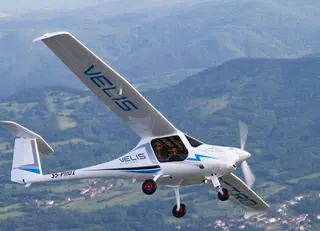Smart and sustainable housing, electric and autonomous automobiles and electric aeroplanes are by no means new to this world, but major technological progress has been made in this field over the last few years. Nevertheless, and despite the fact the world's metropolises feature an increasing number of electric, pollutant gas emission-free vehicles, commercial aviation is composed of a fleet powered by combustion engines, responsible for the generation of greenhouse gases.
However, this year, marked by the significant social and political changes caused by the Covid-19 pandemic, has provided at least one item of good news: AESA, for the first time, has certified a fully electric aeroplane, the Velis Electro. As far as the European institution is concerned, this is “an important milestone in the search for environmentally sustainable aviation” and will be just the first of many vehicles to be awarded this safety seal.

The Velis Electro, created by the Slovenian company Pipistrel Aircraft, thereby becomes the first all-electric plane to be awarded AESA certification, which allows it to operate on a commercial basis. Up to now, electrically powered aircraft could only be used for private purposes. Pipistrel's new creation is the result of “almost twenty years of comprehensive research and development of seven successful, award-winning models since 2007”, explains Taja Boscarol, the company´s communications manager.
Despite this European certification, the Velis Electro will not be used for commercial passenger flights as it has been specifically designed for pilot training and only has two seats. However, its electric engine, which has also been certified, will be sold as an independent product by the Slovenian company, thereby contributing to a greener future in the aviation sector. “It´s considerably quieter than other aeroplanes and doesn´t produce combustion gases”, declares company director Ivo Boscarol.
The engine is equipped with two batteries with a capacity of 24.8 kw/hour, and this model is rechargeable using solar panels, capable of carrying a load of up to 172 kg for 50 minutes of flight at a maximum speed of 200 km/h.
Passenger transport
Early this year, the US company Wright Electric also announced the launch of a project for “the development of electric propulsion” for its 186-seat passenger aircraft, the Wright 1. The aim is to use the electric engine they are developing for commercial flights.
In order to consolidate this sustainable strategy, the company has entered into a partnership with EasyJet, based on the priority “to continue working to reduce their carbon footprint in the short term and to keep up the long-term work involving the development of new technologies” geared to the emergence of electric commercial aircraft.
Wright Electric has revealed that the first tests on the engine under development should take place as early as next year, while the first test flights are scheduled for 2023. Despite the proximity of these dates, the company says that the aircraft will not enter service before 2030. “We are dedicated to placing 186-seat, low-emission electric aeroplanes on the market”, Jeffrey Engler concludes.
